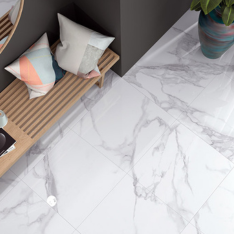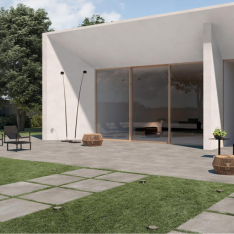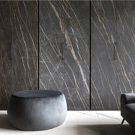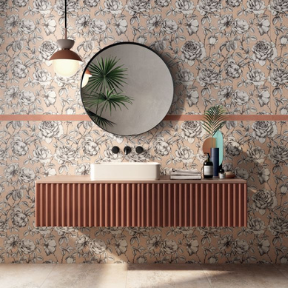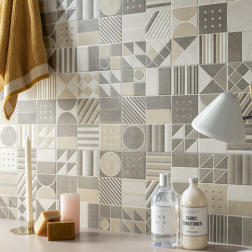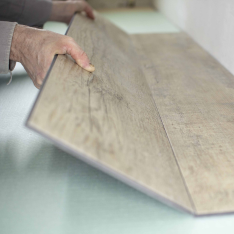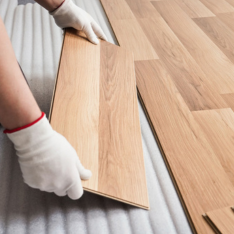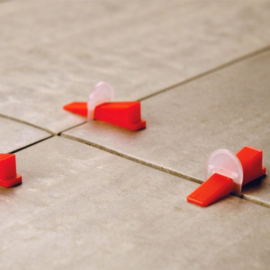When it comes to renovating or furnishing a space, the choice of tiles is crucial. Among the various options available on the market, rectified tiles and non-rectified ones are among the most common. But which of the two is the best choice for your project?
The decision to opt for rectified or non-rectified tiles can affect not only the aesthetics of your space but also its practicality and long-term maintenance. It's important to consider various factors, such as the type of environment, the budget, and the desired visual appearance. As we delve deeper into the characteristics of each type of tile, we will help you make an informed choice.
In this article, we will explore the differences between rectified and non-rectified tiles, analyzing advantages, disadvantages, costs, and much more. You will also discover which type of tile might better suit your needs and style.
What are rectified tiles?
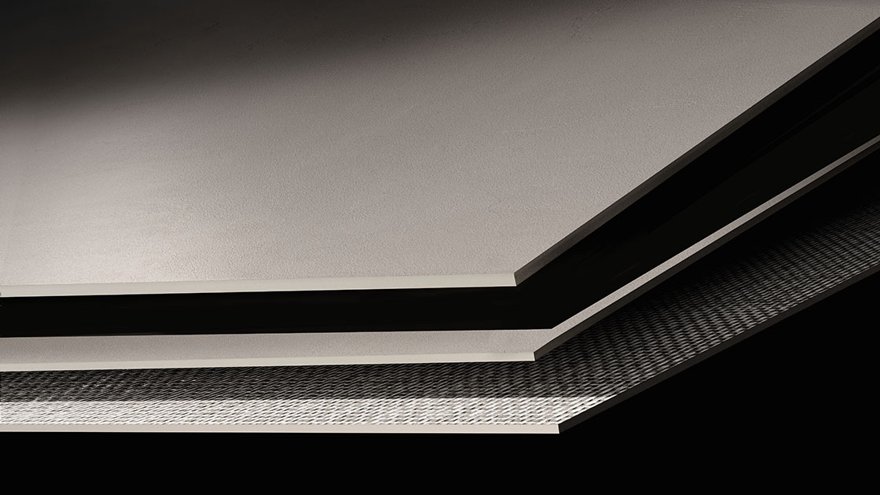
Rectified tiles are a type of tile that has undergone an additional processing step known as rectification. This process involves cutting the edges to a precise size and angle, creating more uniform surfaces and right angles. As a result, rectified tiles fit perfectly together, minimizing the spaces between the grout lines.
Unlike non-rectified tiles, which may have irregular edges and varying dimensions, rectified tiles offer a more modern and clean look. They are available in a wide range of effects and finishes, making them suitable for various applications, from floors to wall coverings.
Rectified tiles are particularly valued in contemporary and minimalist environments, where aesthetics play a crucial role. However, it is also important to consider the context in which they will be used. We will explore the advantages and disadvantages of this type of tile in the upcoming paragraphs.
The Rectification Process: How They Are Made
Tile rectification is a highly specialized process. Initially, tiles are produced using pressing and firing techniques, as is the case with porcelain tiles. After firing, the tiles undergo further mechanical processing.
Stages of the Rectification Process
- Cutting and Grinding. Tiles are cut with precision to achieve standardized dimensions. Subsequently, the edges are ground to remove any irregularities and achieve a perfectly square edge.
- Quality Control. Each tile is inspected to ensure it meets quality standards. Only tiles that pass inspection are classified as first quality.
- Finishing. Finally, tiles may receive finishing treatments to enhance their aesthetic appearance and resistance. This can include glazes, waxes, or stain-resistant treatments.
Thanks to this process, rectified tiles offer dimensional precision that makes them ideal for installation with minimal grout lines. This not only enhances the aesthetics but also facilitates cleaning by reducing the places where dirt and dust can accumulate.
Advantages of Rectified Tiles
1. Modern Aesthetics
One of the main reasons many choose rectified tiles is the clean and orderly look they offer. Thanks to the possibility of laying them with minimal grout lines, these tiles create a continuous effect that is highly appreciated in modern and minimalist contexts. Their precision allows for a uniform surface without visual interruptions, making spaces appear larger and brighter.
2. Ease of Installation
Although laying rectified tiles requires care and precision, their uniformity simplifies the installation process. The tiles fit perfectly together, reducing the risk of errors during installation. Furthermore, the ability to use thinner grout lines makes the entire process faster and less laborious.
3. Simplified Maintenance
With smaller grout lines, rectified tiles are less prone to accumulating dirt and debris. This means cleaning is simpler and faster. Additionally, many rectified tiles are treated to resist stains, making them ideal for high-traffic areas or spaces like kitchens and bathrooms.

Disadvantages of Rectified Tiles
1. Higher Cost
One of the main disadvantages of rectified tiles is the price. The rectification process requires more processing and quality control, which translates into a higher cost compared to non-rectified ones. If you have a limited budget, this is a factor to consider carefully before making the final choice.
2. Fragility
Rectified tiles can be more fragile than non-rectified ones, especially if they haven't been properly treated. The cut edges can be vulnerable to impacts and scratches, meaning care must be taken during installation and daily use. This can be problematic in high-traffic environments.
3. Professional Installation Required
Laying rectified tiles requires a high level of expertise. If you don't have experience with tile installation, it is advisable to hire a professional. Errors during installation can compromise the final appearance and durability of the tiles, thus requiring additional labor costs.
Aesthetic Differences Between Rectified and Non-Rectified Tiles
When it comes to aesthetics, rectified and non-rectified tiles show significant differences. Rectified tiles offer a more contemporary and clean look, thanks to their uniform surface and minimal grout lines. This makes them particularly suitable for modern and minimalist environments.
On the other hand, non-rectified tiles may have irregular edges and variations in size, giving them a more artisanal and rustic appearance. This style may be preferred in more traditional contexts or in environments aiming to convey warmth and welcome.
Cost Comparison: Rectified vs Non-Rectified
When analyzing costs, it's important to consider not only the initial price of the tiles but also the costs associated with installation and maintenance. Generally, rectified tiles are more expensive than non-rectified ones. However, a deeper analysis might reveal that the additional expense for rectified tiles can pay off in the long run.
Tile Costs
- Rectified Tiles. Average prices vary, but generally higher than non-rectified tiles. Costs can range from €25 to €60 per square meter, depending on the design and finish.
- Non-Rectified Tiles. More accessible prices, varying from €10 to €30 per square meter. Ideal for those with a limited budget.
Installation Costs
Laying rectified tiles can require more time and professional skills, increasing installation costs. On average, installation costs for rectified tiles can be around €20-€30 per square meter, while for non-rectified tiles, it can drop to €10-€20.
Final Considerations
Although the initial price of rectified tiles is higher, the long-term savings from reduced maintenance and durable aesthetics may justify the investment. It is crucial to evaluate your needs and the context in which the tiles will be used.
Installation: Differences Between the Two Types of Tiles
1. Installing Rectified Tiles
Laying rectified tiles requires care and precision. Their uniformity allows for minimal grout lines, meaning the final result will be a floor or wall with a smooth, continuous look. It's important to use a high-quality adhesive and ensure the substrate is perfectly level for optimal results.
2. Installing Non-Rectified Tiles
Non-rectified tiles, with their irregular edges, require more attention during installation to ensure a uniform appearance. Wider grout lines can hide small irregularities, but still require skill to achieve quality work. In this case, the adhesive and substrate preparation are just as critical.
3. Installation Tips
- Use appropriate tools. Regardless of the tile type, using quality tools is essential for precise work.
- Check for levelness. Ensure the substrate is perfect to avoid problems after installation.
- Follow manufacturer's instructions. Each type of tile and adhesive has specific installation instructions that must be followed.
Minimum Grout Line for Rectified Tiles
One of the distinctive features of rectified tiles is the possibility of using minimal grout lines. This not only improves aesthetics but also offers practical advantages. With thinner grout lines, the risk of dirt and dust accumulation is reduced, facilitating daily cleaning.
What is the minimum grout line for rectified tiles?
As a general rule, a minimum grout line of 1.5 mm is recommended for rectified porcelain tiles. However, some manufacturers and experienced installers suggest not going below 2 mm for added safety and to compensate for any building settlement.
Advantages of Minimal Grout Lines
- Improved aesthetics. Thin grout lines create a uniform, modern look, ideal for elegant environments.
- Ease of cleaning. Fewer grout lines mean fewer spaces where dirt and stains can accumulate, making maintenance simpler.
- Resistance. In many cases, minimal grout lines in floors and walls are more resistant to cracks and damage, thanks to greater adhesion between the tiles.
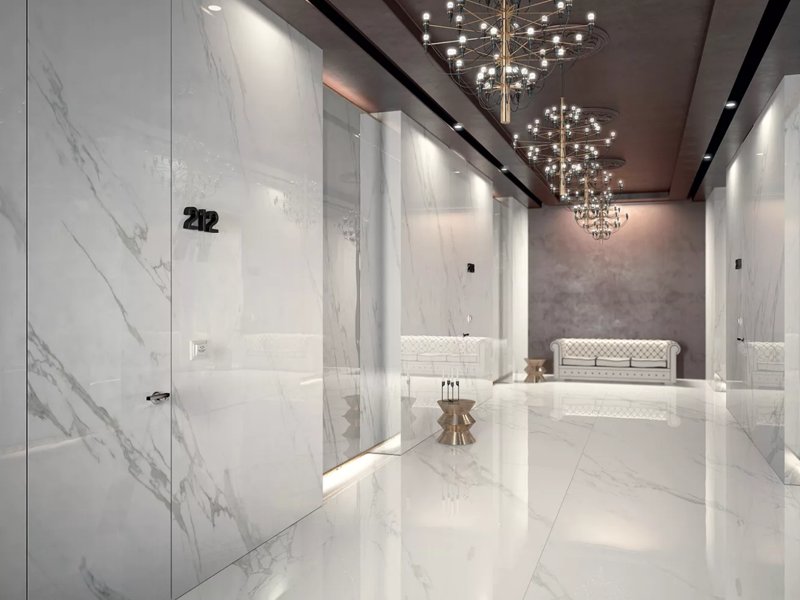
Maintenance and Cleaning: Which Type is More Practical?
When it comes to maintenance and cleaning, rectified tiles offer significant advantages. Their uniform surface and minimal grout lines reduce the time and effort needed to keep the area clean. However, it's also important to consider the tile material.
1. Cleaning Rectified Tiles
Rectified tiles can be easily cleaned with a broom or vacuum cleaner followed by a damp cloth. For tougher stains, specific cleaners for the tile material can be used. Avoid abrasive products that could damage the surface.
2. Cleaning Non-Rectified Tiles
Non-rectified tiles, due to their wider grout lines, may require more time for cleaning, as dust and dirt particles tend to accumulate in the joints. More regular cleaning is advisable to maintain the original appearance.
3. Final Considerations
In general, rectified tiles are more practical for daily maintenance, but the final choice should also be influenced by the material and desired style. Be sure to consider your cleaning habits and the time you are willing to dedicate to maintenance.
When to Choose Rectified Tiles
Opting for rectified tiles is advisable in several situations. If you are designing a modern and minimalist environment, rectified tiles can offer the desired aesthetics. Furthermore, if you are renovating a high-traffic area, the durability and ease of maintenance of rectified tiles can make a difference.
Ideal Situations for Rectified Tiles
- Modern Renovations. If your goal is an elegant and contemporary space, rectified tiles are the perfect choice.
- High-Traffic Environments. Thanks to their resistance and ease of cleaning, rectified tiles are ideal for kitchens, bathrooms, and commercial areas.
- Design Projects. When you desire a uniform and smooth look, rectified tiles will allow you to achieve optimal results.
Purchasing Tips: What to Consider Before Deciding
Before purchasing rectified or non-rectified tiles, there are some key factors to consider. These points will help you make an informed and satisfactory choice.
- Budget. Establish a clear budget before starting your search. Consider not only the cost of the tiles but also the installation and maintenance costs. Rectified tiles may involve a higher investment but can also offer long-term savings.
- Style and Design. Think about the overall style of your space. If you are looking for a modern and clean look, rectified tiles might be the best choice. However, if you prefer a more rustic or traditional atmosphere, non-rectified tiles might be more suitable.
- Use and Functionality. Consider the intended use of the tiles. If they will be installed in a high-traffic area, it's better to opt for durable and easy-to-maintain tiles.
Conclusions
The choice between rectified and non-rectified tiles depends on various factors, including your budget, desired style, and practical needs. Rectified tiles offer aesthetic and maintenance advantages but may come at a higher cost. On the other hand, non-rectified tiles can be more economical and suitable for more traditional styles.
Ultimately, your project deserves careful attention and an informed decision. Consider all the information provided in this article to choose the type of tile that best meets your needs.


